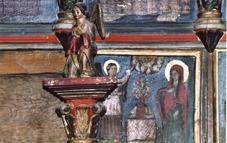-
The Orthodox Church represents a visible and unitary image of the
Universe, a holistic construct of the perceptible and intangible world
that encompasses God, the Kingdom of God, and Heavenly Jerusalem. As
such, the Church delineates a universality that some people believe
guides the historical course of the world. The discernible aspects of
the Church as a building per se, are designed to correlate with the
practice of the holy sacraments. As one passes through the entrance and
proceeds in the direction of the altar, the holy experiential religious
practices, in conjunction with the physical structure and contents,
brings one ever nearer to the Seven Sacraments, the most important and
grandiose characteristics of the Church.
The fabric of the Church is divided into three main parts: the vestibule,
the space in the forefront of the temple; the nave or middle part; and
the altar or sanctuary, the holiest place in the Church. Each part of
the structure and every object within the building signifies special
meaning and purpose. Passage through the renowned doors transports one
to a state of spiritual ascendancy on the road that every Christian
follows in pursuit of a higher metaphysical life. Traversing the
vestibule connotates preparedness for entry into the designated middle
section of the Church, the nave, and being accepted as a denominated
member of the Church since it is in the vestibule that the first two
sacraments, christening and the rite of confirmation, take place. For
baptized members, the sacraments of confession, extreme unction, and
marriage take place in the nave of the church. In this sense everything
leads towards the altar, the honorific place where the temple’s holiness
is concentrated and where “God is keeping his eyes open night and day.”
(111 Kings 8, 29.)
During the holy liturgy, the Son of God is perceived to ascend into a
fatidic state on an altar above the heavens where He becomes a symbol of
sacrifice to whom believers pay homage. The altar, therefore, represents
a simulacrum of beatific Mount Zion and the cosmic center for the
holy-communion table, a symbol of Jesus Christ the Saviour. It is from
here, in front of the splendid doors of the altar, that the priest gives
the Eucharist, the consecrated elements of bread and wine, to thirsty
and hungry spiritual believers. Those who have received the honorific
Eucharist become hallowed “bearers of Jesus Christ.” In the intimacy of
the anterior of the altar and the communion table, those who have been
especially chosen and spiritually prepared, receive the Priesthood
Sacrament according to their rank of bishop, priest, or deacon.
|
-
Orthodox religion influences the architectural
design of the Church as well as the decorative painting and sculpture of
the building. It is also the fountainhead of the sacred art of
harmonizing everything with the liturgical mystery and the sacramental
service, creating an atmosphere of restfulness, an ambiance that is
visualized in the religious paintings of the Church and felt in the
continuous presence of the holy persons who painted the artworks. The
architecture of the Orthodox Church is different from that of the
Western Church as it results from a different kind of spirituality.
Lucian Blaga speaks of the essence of the bipolar spiritualities, East
and West, when he emphasizes the fact that the Byzantine church uses the
inner architecture of the church to suggest a ‘meeting’ of man ‘in the
midst’ of God. This is not something, he says, that is emphasized in the
structure of Gothic and Roman Churches. The Byzantine Church’s interior
reflects the universe; it is a liturgically organized cosmos where
“Every soul praises the Lord.”
The Orthodox Church is a place where the sky meets with the earth. It is
a figurative ‘Jacob’s Ladder’ where angels and saints are able to
descend towards earth and where people on earth are able to ascend to
the sky, animating a unique lexicon in praise of the Lord. One of
Triodyon’s songs to the Blessed Virgin suggests this idea when it says,
“Standing in your Church’s celestial heights we are seen to be in heaven,
Blessed Virgin.” The architectural design of the Orthodox Church, in
the form of a cross and topped by a Pantacratos cupola constructed in a
configuration that represents the shape of the sky above earth, creates
an encompassment that brings one nearer to heaven and helps bring the
bible alive in a way that empowers Christians to visualize God and feel
His presence. The content and placement of the paintings on the walls of
the Churches accentuates the effect.
Churches are like flowers. They grow only in certain places but their
fragrance can be detected from long distances away when someone is
capable of identifying the scent.
The mission of Jesus Christ takes many different forms and approaches in
concordance with the times in which one lives. In this vein, we
congratulate our good friend Mr. Petru Russu on the initiative he has
taken in his endeavour to publish an album about the oldest church in
Reghin, the ‘Saints Archangel’s Church’, formerly the parish of Petru
Maior, Arch-episcopate of Alab-Iulia. We hope that whoever explores
Petru Russu’s album will envision a connection to the Church of Jesus
Christ and, as well, recognize the Holy transformation in Transylvania.
The Archpriest
Teodor Beldean
Reghin, 10th of December 2002
|

